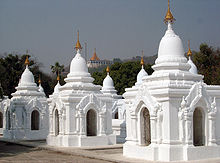Tripitaka
Appearance







An Tipiṭaka (pi) o Tripiṭaka (sa) , nangangahulugan na "Tripleng Basket",[1] iyo an tradisyonal na termino para sa suanoy na koleksyon kan Buddhist sacred scriptures.[1][2][3][4]
Toltolan
[baguhon | baguhon an source]- ↑ 1.0 1.1 Keown, Damien, ed. (2004). "Tripiṭaka". A Dictionary of Buddhism. Oxford: Oxford University Press. doi:10.1093/acref/9780198605607.001.0001. ISBN 9780191726538. Archived from the original on 2021-09-23. Retrieved 2021-09-23. Unknown parameter
|url-status=ignored (help); Unknown parameter|contribution-url-access=ignored (help) - ↑ • Harvey, Peter (23 September 2019). "The Buddha and Buddhist sacred texts". www.bl.uk. London: British Library. Archived from the original on 12 November 2020. Retrieved 23 September 2021. Unknown parameter
|url-status=ignored (help) • Barrett, T. H. (23 September 2019). "Translation and Transmission of Buddhist texts". www.bl.uk. London: British Library. Archived from the original on 25 February 2021. Retrieved 23 September 2021. Unknown parameter|url-status=ignored (help) • Barrett, T. H. (23 September 2019). "The Development of the Buddhist Canon". www.bl.uk. London: British Library. Archived from the original on 7 April 2021. Retrieved 23 September 2021. Unknown parameter|url-status=ignored (help) - ↑ Error sa pag-cite: Imbalidong
<ref>tatak; mayong teksto na ipinagtao para sa reperensiya na pinagngaranan nabritannicatipitaka - ↑ "Buddhist Books and Texts: Canon and Canonization." Lewis Lancaster, Encyclopedia of Religion, 2nd edition, pg 1252
